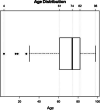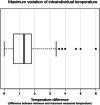Core body temperatures during final stages of life-an evaluation of data from in-hospital decedents
- PMID: 35689684
- PMCID: PMC9375749
- DOI: 10.1007/s00414-022-02837-7
Core body temperatures during final stages of life-an evaluation of data from in-hospital decedents
Abstract
Temperature-based methods are widely accepted as the gold standard for death time estimation. In the absence of any other information, the nomogram method generally assumes that a person died with a core body temperature of approximately 37.2 °C. Nevertheless, several external and internal factors may alter the body temperature during agony. A retrospective medical record analysis was carried out on in-hospital death cases from two consecutive years of surgical intensive care units to determine the effects of factors influencing the core body temperature at the point of death. Data from 103 case files were included in the statistical data evaluation. The body temperature fluctuated between and within individuals over time. No clear correlation to certain death groups was observed. Even primary cardiac deaths showed broad intervals of temperatures at the point of death. Men seem to die with higher body temperatures than women. The presented data highlight potential biases for death time estimations when generally assuming a core body temperature of 37.2 °C. In conclusion, the estimation of the time of death should include various methods, including a non-temperature-dependent method. Any uncertainties regarding the body temperature at point of death need to be resolved (e.g. by identifying fever constellations) and elucidated if elimination is not possible.
Keywords: Agony; Death time; Estimation; Influence factors; Nomogram; Temperature.
© 2022. The Author(s).
Conflict of interest statement
The authors declare no competing interests.
Figures











Similar articles
-
Influence of hypo- and hyperthermia on death time estimation - A simulation study.Leg Med (Tokyo). 2017 Sep;28:10-14. doi: 10.1016/j.legalmed.2017.06.005. Epub 2017 Jun 27. Leg Med (Tokyo). 2017. PMID: 28732225
-
A Novel Environment-Invariant Core Body Temperature Estimation for High Sensitivity and Specificity Fever Screening.Annu Int Conf IEEE Eng Med Biol Soc. 2018 Jul;2018:1612-1615. doi: 10.1109/EMBC.2018.8512541. Annu Int Conf IEEE Eng Med Biol Soc. 2018. PMID: 30440701
-
Estimation of the time since death based on body cooling: a comparative study of four temperature-based methods.Int J Legal Med. 2021 Nov;135(6):2479-2487. doi: 10.1007/s00414-021-02635-7. Epub 2021 Jun 19. Int J Legal Med. 2021. PMID: 34148133
-
Comparison of brain temperature to core temperature: a review of the literature.J Neurosci Nurs. 2004 Feb;36(1):23-31. doi: 10.1097/01376517-200402000-00004. J Neurosci Nurs. 2004. PMID: 14998103 Review.
-
New onset fever in the intensive care unit.J Assoc Physicians India. 2005 Nov;53:949-53. J Assoc Physicians India. 2005. PMID: 16515235 Review.
Cited by
-
Estimation of postmortem interval under different ambient temperatures based on multi-organ metabolomics and machine learning algorithm.Int J Legal Med. 2025 Sep;139(5):2561-2575. doi: 10.1007/s00414-025-03523-0. Epub 2025 May 27. Int J Legal Med. 2025. PMID: 40423808
References
-
- Henssge C, Madea B. Determination of the time since death. I. Body heat loss and classical signs of death. An integrated approach. Acta Med Leg Soc (Liege) 1988;38(1):71–89. - PubMed
MeSH terms
LinkOut - more resources
Full Text Sources
Medical

